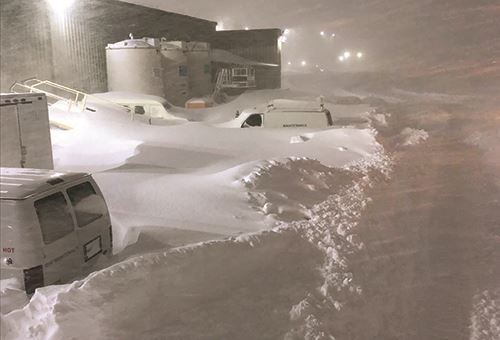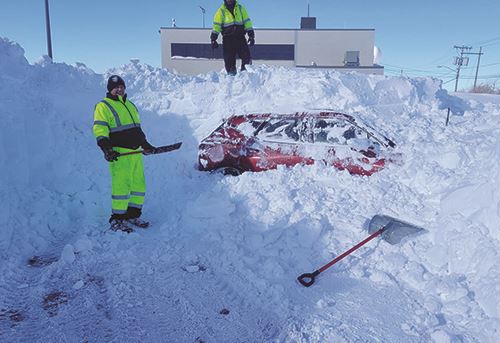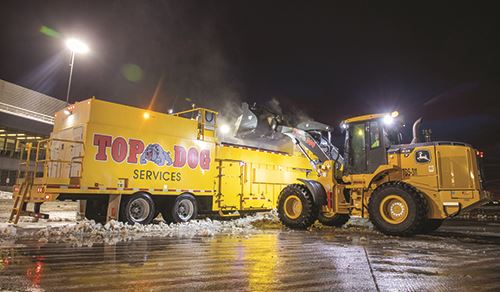The snow removal team at Buffalo Niagara International Airport (BUF) is nationally recognized as one of the best in the business, with impressive credentials including 10 Balchen/Post Awards for excellence in snow and ice control. When a historic blizzard tested the team’s mettle this past December, it rose to the challenge in dramatic fashion.
The snow removal team at Buffalo Niagara International Airport (BUF) is nationally recognized as one of the best in the business, with impressive credentials including 10 Balchen/Post Awards for excellence in snow and ice control.
When a historic blizzard tested the team’s mettle this past December, it rose to the challenge in dramatic fashion. In addition to clearing snow and ice from the airfield, the 30-member squad helped firefighters and police rescue nearly 100 motorists stranded on airport grounds and surrounding perimeter roads. The record-setting storm that began on Christmas weekend dumped 49 inches of snow in 72 hours (51.5 inches overall) and killed more than 40 people in the Buffalo area. But none perished at or near the airport.
The so-called “blizzard of the century” shut down the airport, located in the Buffalo suburb of Cheektowaga, NY, from 12:38 p.m. on Friday, Dec. 23 until 11 a.m. on Wednesday, Dec. 28. An estimated 500-plus flights in and out of BUF were cancelled, and the terminal served as a makeshift motel for around 190 people, including airport and concessionaire employees, for days on end. Airport administration quickly scrambled to provide water, food and basic comfort items such as cots, blankets and pillows.
|
facts&figures Project: Snow Removal/Rescue Operations Location: Buffalo Niagara Int’l Airport, Cheektowaga, NY Weather Event: 2022 Christmas-weekend blizzard 2022 Passenger Volume: About 4 million Snowfall: About 50 inches in roughly 70 hours Other Factors: 40- to 50-mph winds, with peak gusts of 72 mph; zero visibility; wind chill temperatures of -20 F; 10- to 12-foot-high drifts People Rescued: Nearly 100 Est. Flights Cancelled: More than 500 Shutdown Duration: Nearly 5 days Snow Removal Equipment: Batts Inc.; John Deere; Fort Miller FAB3 Corp.; Hyundai; M-B Companies; Oshkosh Airport Products; Trecan; Tyler Assisting Contractors: Lakestone Development; Top Dog Services |
“I’ve never seen anything like it in 40 years in this business—and hope I never do again,” reflects BUF Airfield Superintendent Joe Guarino. “The blizzard was relentless, just relentless, with blinding snow, wind chill temperatures down to minus 20 degrees and steady winds at 40 to 50 miles per hour, with gusts up to 72 miles per hour.
“We always feel we can handle just about anything Mother Nature throws at us,” he continues, noting that BUF has never shut down for more than a few hours at a time despite annual barrages of winter storms fueled by lake-effect snow surges off Lake Erie.
“No one is more passionate about keeping the airport open than me. But as tough as it was to do, we had to close down for the safety of our crews and the traveling public,” Guarino explains. “Safety is our first and foremost concern.”
From Bad to Worse
Rain switched to snow around 7:40 a.m. on Friday, and conditions deteriorated quickly. By around 9 a.m., visibility was so bad that Guarino literally could not see his hands in front of his face while out on the airfield with his crews, trying to keep the airport’s 8,829-foot main runway clear.
“Our equipment drivers had a couple of inches of ice on their windshields, even with their heaters going full blast,” he recalls. “Some operators had to stick their heads out their windows to see where they were going.”
 Shortly after 9 a.m. Friday, BUF officials closed the 7,160-foot crosswind runway. About the same time, Guarino told equipment operators to carefully make their way back to the Operations Center at the southwest corner of the airport grounds. They were instructed to notify him when they arrived, so he could make sure all operators out on the airfield were safely indoors.
Shortly after 9 a.m. Friday, BUF officials closed the 7,160-foot crosswind runway. About the same time, Guarino told equipment operators to carefully make their way back to the Operations Center at the southwest corner of the airport grounds. They were instructed to notify him when they arrived, so he could make sure all operators out on the airfield were safely indoors.
“While driving, they had to maintain situational awareness via two-way radios because they couldn’t see each other,” Guarino says.
Niagara Frontier Transportation Authority (NFTA), which owns and operates BUF, soon made the decision to close the airport. In a notice to air missions (NOTAM), officials said that they expected to open in about 24 hours. But at 7 a.m. Sunday, the airport issued another NOTAM alerting pilots that BUF would be closed through at least Monday.
“We were getting buried,” Guarino says. “In some spots, we had 10- to 12-foot-high drifts on the airfield.”
Little did Guarino know that the original plans to reopen were overly optimistic…or that the real work for his crews had only just begun.

Converting to Rescue Mode
About three hours after BUF closed, the focus shifted to helping stranded motorists. By late Friday night, nearly 100 people had been rescued by snow-removal employees, NFTA Transit Police officers and BUF firefighters stationed at the airport and even employees of Lakestone Development, a local contractor that helps plow snow at BUF.
 “People all over the airport or near it were stuck,” says Bill Major, chief of NFTA’s Fire and Emergency Services Department.
“People all over the airport or near it were stuck,” says Bill Major, chief of NFTA’s Fire and Emergency Services Department.
Calls from stranded motorists streamed in to the airport police and the fire departments from both the Cheektowaga and Erie County 911 centers.
“Some folks told us they had flown in for Christmas, rented a car and then weren’t familiar with the area and got disoriented and stuck,” Major says, explaining why people were out driving in such severe weather. “Others said they were running last-minute errands and got caught in the storm, which got stronger a lot faster than people anticipated.”
A cluster of calls came from motorists trapped on Aero Drive, which winds around the northeast side of the airport and passes through a tunnel under the main runway. People apparently thought the tunnel would provide protection from the raging storm, but instead a wind-tunnel effect quickly filled it with snow.

Fire Chief Major and Assistant Chief Joel Eberth responded creatively, directing the eight on-duty airport firefighters to use Oshkosh aircraft rescue and firefighting vehicles and an eight-wheel all-terrain vehicle made by Argo (on loan from the nearby Hy-View Fire Company) to move people from the tunnel to the firehouse, roughly a quarter-mile away. Airport employees cleared a path for them as best they could.
“Even our 35-ton, six-wheeled, all-wheel-drive crash trucks were getting stuck,” Major reports. “But we had to keep going. None of the folks picked up by our department and the Transit Police would’ve survived overnight in those conditions.”
By Friday night, 44 people were safe and sound in the fire department. The next evening, conditions improved enough for them to move to the terminal.

More Calls for Help
At Transit Police headquarters, 11 officers were on duty. They made their first rescues around noon on Friday. One was a man with medical issues; his daughter called 911 after she lost cellphone contact while talking to him. Another was a motorist who drove off the road and into a deep snow embankment.
“Visibility was so poor that I walked in front of the two squad cars to guide them back to the police station,” recalls Louis Loubert, captain of the airport’s Transit Police. “I’ve never experienced a blizzard like this one. It was like being inside a giant snow globe.”
 One of the other rescues Loubert recalls involved two motorists stuck near the Aero Drive tunnel. The woman called 911 Saturday afternoon and said her car was running out of gas and her boyfriend, who had given her some of his clothes to keep her warm, was showing symptoms of hyperthermia.
One of the other rescues Loubert recalls involved two motorists stuck near the Aero Drive tunnel. The woman called 911 Saturday afternoon and said her car was running out of gas and her boyfriend, who had given her some of his clothes to keep her warm, was showing symptoms of hyperthermia.
So six officers headed out on foot. To ensure they could find their way back, they tied the end of a roll of yellow crime-scene tape to a traffic sign in front of the police station and unrolled it as they walked. Officers found the car buried up to its roof in snow. The boyfriend’s feet and hands were purple and he was drifting in and out of consciousness.
“We put his arms around the shoulders of two officers, who half-dragged him back to the station, roughly three-quarters of a mile away. Had we not reached him, he definitely would’ve expired,” Loubert explains soberly.
During another night rescue, an officer using a flashlight saw an odd-looking reflection in a street and discovered it actually was the headlight of a car that was almost completely covered by drifting snow.
“We realized that we were walking on top of buried cars,” he says incredulously.

Officers had to line their path with road flares, placed about every 10 feet, to help them find their way back to the station.
By Saturday afternoon, nearly two-dozen people and a dog were safely inside the police station. Because the station had no food, they were slowly moved to the terminal Saturday evening by a convoy of squad cars, with an airport snowblower and a front-loader clearing the way.
“That’s normally about a four-minute drive, but it took us almost a half-hour to get to there,” Loubert says. “The road was filled with abandoned vehicles. I took a video of the trip and in one 15-second clip, we counted 17 abandoned vehicles on Wherle Drive (at the airport’s northern boundary).”
By Sunday, all stranded civilians and airport personnel had been transported to the terminal.
Survival Mode
Meanwhile, employees at Signature Flight Services, the fixed-base operator at BUF, also were battling the fierce elements on the 16 acres of ramps and parking lots the company maintains for general aviation operations.
General Manager Brian Evaldi says that his employees’ primary goal was trying to keep a path cleared between the facility’s offices and three hangars. Employees were stationed at two of the hangars, so his main concern was keeping a driving lane cleared in case anyone required emergency services.
 “We were in survival and property-preservation mode,” he explains. “We were able to keep a path to the hangars cleared with a wheeled front-loader. But at times, it felt like we were using a spoon to empty sand from a sandbox.
“We were in survival and property-preservation mode,” he explains. “We were able to keep a path to the hangars cleared with a wheeled front-loader. But at times, it felt like we were using a spoon to empty sand from a sandbox.
“We also were asked to try and clear a path from our facility to the police station and from the police station to the firehouse,” he adds. “But we only made it to the police station…We stopped because no one could see anything in front of them.”
On Monday, food reserves for the 14 or so Signature employees began to run low. The same was true in the terminal, where stranded motorists, passengers and airport personnel were living primarily on food supplied by the Anchor Bar restaurant, which fortunately had received a large shipment of chicken fingers and French fries just before the storm hit.
“We had to ration them out to make them last for a few days, and supplemented them with sandwiches from grab-and-go concessionaires,” Major says.
Across the airfield, Evaldi switched into DoorDash mode and drove to Wegmans, a local grocery store where his wife is a manager.
“I made two trips and filled the back of my Ford F-250 pickup truck with food, plus the back seat of the crew cab,” Evaldi says, noting that Wegmans didn’t charge him anything for the valuable rations. “The roads were passable at that point, but very narrow. The snow on either side was up to the bottom of my truck window, so it was almost like driving through a tunnel.”
Digging Out
It took about two days for Airfield Operations employees and an outside contractor, Top Dog Services, to clear enough snow for the airport to re-open.
Several dozen abandoned vehicles were towed to an empty parking lot. Perimeter roads were blocked by 10- to 12-foot-tall drifts. And all the baggage carts and ground service equipment parked up against the terminal were buried under snow.
“It was a mammoth task,” Guarino recalls. “We had to clear the main runway, the taxiways and the crosswind runway. Plus the fuel farm was buried; it took a day just to dig out that area.”
To remove snow, the team relied on:
- an MB5 combination snow plow and broom machine
- four MB5E combination plow, broom and deicing machines
- two sanding trucks equipped with Tarco sanders manufactured by Fort Miller FAB3 Corp.
- seven Hyundai and John Deere front-end loaders
- two P Series roll-over plows with underbody blades and three P series front-mount plows from Oshkosh Airport Products
- three Trecan 135-PD snow melters
- six Oshkosh trucks equipped with M-B auxiliary front-mount brooms
- four Oshkosh rotary plows
- one M-B rotary plow
- two deicer trucks, one from Tyler (a brand owned by Wausau Equipment Co. Inc.) and one made by Batts Inc.
“It was a huge job to get things unburied and operational,” Guarino emphasizes. “That’s why it took so long to re-open the airport.”
Moreover, police had to check thousands of cars in airport parking lots to be sure they were unoccupied. To indicate a vehicle had been checked, officers turned its windshield wipers to the upright position.

The Big Melt
Top Dog employees played a key role in the mammoth snow removal operation. The Maryland-based contractor also brought in three snow-melting machines capable of melting 80, 135 and 180 tons of snow per hour,
“Without those Top Dog snow melters, we would’ve had piles of snow around here until July,” Guarino quips. “They did amazing work.”
Top Dog crews also helped Signature Flight Services employees dig out and melt snow at their facilities.
“In 19 years, we’ve always been able to dig ourselves out,” Evaldi says. “But not this time.”
 Todd Dickerson, owner, president and chief executive officer of Top Dog, reports that his crews worked around the clock for about 86 hours. They strategically stationed one melter by the airport parking lots, another by the main ramp and another by the taxiways.
Todd Dickerson, owner, president and chief executive officer of Top Dog, reports that his crews worked around the clock for about 86 hours. They strategically stationed one melter by the airport parking lots, another by the main ramp and another by the taxiways.
“We melted a little less than 50,000 tons of snow,” he relates.
Dickerson says that snow melters are one of the most efficient ways to remove snow, especially from ramp areas where there is not much room to pile up large amounts of plowed snow. David MacEachern, sales manager for Trecan, reports that a Trecan 135-PD unit can melt the equivalent of 25 tandem-axle dump trucks full of snow in just an hour.
In short, the machines use water and heated air to melt snow. Crews load snow into the machine’s tank, which is filled about 60% full of water; heated air is injected to warm the mixture to temperatures between 35 F and 39 F—just enough to melt the snow. Injecting the air forcefully causes agitation, which speeds up the melting process. Melted snow drains out of the tank through a gravity-fed overflow tube and into stormwater drains.
 “The neat thing about the design is that there’s nothing mechanical involved in the melting process. It’s essentially just hot air,” MacEachern remarks. “There are no augurs that can get clogged up.”
“The neat thing about the design is that there’s nothing mechanical involved in the melting process. It’s essentially just hot air,” MacEachern remarks. “There are no augurs that can get clogged up.”
High Praise for Weathering the Storm
All officials interviewed about the blizzard response expressed deep gratitude for the dedication and diligence of their employees—and also cite them as a major reason why no lives were lost at or around the airport.
“I’m very proud of my staff,” Guarino stresses. “They risked their lives to save others, then had to remove all that snow to reopen the airport. Their efforts leave me speechless.”
“My staff went above and beyond the call of duty,” says Major. “But if you ask them, they’ll tell you they were just doing their jobs.”
Employees also demonstrated emotional warmth amid their stressful duty. For instance, firefighters scrounged up a doughnut and candle from the fire station to create a birthday “cake” for a stranded teenager. And when Assistant Fire Chief Eberth learned that a young boy was concerned Santa wouldn’t be able to find him, he asked airfield staff to help. They got gifts from a retail store at the terminal and delivered them to the fire station, where Eberth and crewmembers wrapped them and placed them under the station’s Christmas tree for the boy.
Evaldi thinks Guarino deserves a reward for the way he and his team responded. “Signature is blessed to work with such an outstanding and experienced staff,” he says. “Joe and his people never worried about themselves, they just worried about
everyone else.”
Dickerson praised the cooperation cultivated by Guarino and his employees. “It was really refreshing to work as a team during a very difficult time,” he remarks. “There were no egos involved. Everyone just worked together to get the job done safely and as fast as possible. That doesn’t happen a lot, so it was very rewarding.”
Loubert says he is proud of how his officers came together to work as a team even though many usually work different shifts. “And as I look back, I’m grateful that while 40-some people died during the blizzard in the Buffalo area, we didn’t lose anyone here at the airport,” he emphasizes. “That was the biggest reward of all.”



